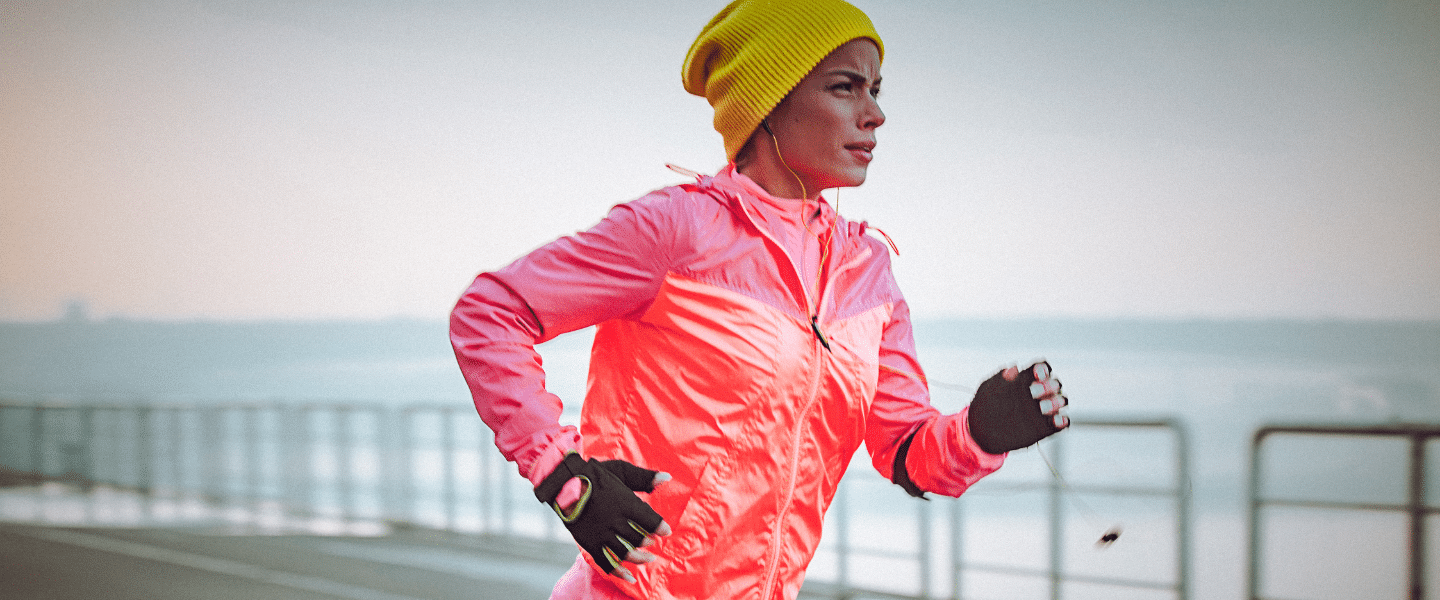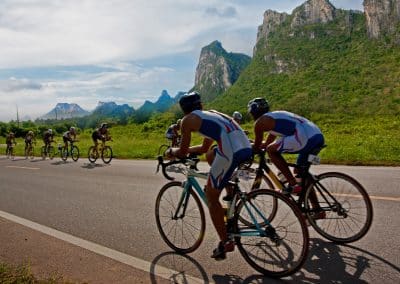Thank you so much for having me. It's always nice to get to chat with you.
We're talking about cold-weather gear. If I want to run outside and it's cold, can I throw some joggers and a winter coat?
Totally, but you're not going to enjoy your run. The number one thing that I care about is that if people are running, it's because they love and enjoy it and want to be out there. For me, dressing is the easy part. It seems complicated. I'm sure we will get into this. If you're wearing the right gear, you're going to have a far more enjoyable run. I'm not saying it's going to be easy. Running is always hard.
Running is never easy, but it always feels good to have it done.
If you dress the part, you're not going to be freezing one mile. You're going to ease in and feel good. I care a lot about making sure that people do whatever they can to make running enjoyable. There are things we can control. We can't control the weather, but we can control how we dress for it.
I'm a runner who's never run outside in the cold. What considerations do I need to think about?
Layers are going to be key. Layers are super important that way. If you do get warm, you can strip them off. You're always going to want to look at the real feel. It's so silly. I always say, Look at the weather. Check the weather.
You can also step outside and see how it feels. It's always going to seem colder than it will be when you're running. You always want to dress for a little bit warmer than the temperature is. If it's cold out, when you step out the door before you've started running, you're going to be cold.
Maybe for the first half mile or the first few minutes, you might be cold. The goal is that once you're easing into the run, you're comfortable that you're not overheating, but you're not freezing either. Check the temperature and plan accordingly. I'm sure we'll get into how to plan. The first thing is to know that it is cold, and don't let that scare you either because it's 30, 20, whatever degrees people measure as cold.
If people from California are reading, they're like, Sixty degrees is cold,
whereas I'm in New Hampshire, and I'm like, No, Negative 10 isn’t too bad. That’s doable.
Cold is relative to everyone, but cold isn't necessarily a reason not to get out and run. I like people to keep that in mind too. Don't let the weather kill the motivation that you have. If you're motivated to get out there, we're going to get you out there.
When you say planning, what goes into the planning? You can't wake up the day of a run and decide I'm going to go outside and run if you don't have the gear. You need to know what you need, but you don't know what the temperature's going to be. How do we do this?
Everyone's body is different. I know that for me. My legs are good to go. I don't usually need to layer up my legs. They're moving when I'm running. Some people, their legs get cold. Everyone is different, as with anything in the running. Everything is personal. I know that for me, my legs are okay. I will run in shorts until it's about 30 degrees out.
In the past, 20 degrees was my threshold. I'm getting softer as I get older. Now I'm in the pants a little bit earlier. Some people's ankles get cold. If you're someone whose ankles get cold, let's make sure that your pants either come down to your ankles or you've got socks that are going to come high enough. It's like women's pants. They're big on seven-eighths in length.
I don't know why. Give me 8 out of 8. There's that little bit of skin that shows. I have a lot of friends who are like, I come back,
and that bit of skin is frostbitten. It is raw or red. For me, my little bit of skin does okay. If it's cold or windy, which is a whole other factor we can get to, I might want to make sure that that is covered. Wear high socks or pants that come all the way down. On the top half, layering.
I wear a sports bra that is more like a crop top. It's a little bit longer at the bottom. I usually will have on a thin, long sleeve, that is a technical shirt. It's breathable, but it's also warm. It is made for performance. My top layer is either going to be a running jacket or a running vest. I love a vest. My husband hates a vest. I live for a vest because my arms are moving as I'm running. Any body part that is moving is a little bit less likely to get super cold.
If my arms are pumping as I'm going, my arms are going to be okay. I like a vest so that my arms can breathe a bit. Other key factors for me are good gloves or mittens and something good for your head, whether it's air warmer or a hat. I do a hat if it's very cold. Otherwise, an ear warmer and gloves will usually suffice. You want good gloves or mittens. If it's really cold, my extremities get cold first, my fingers and toes, hot hands and warmers like when you're going skiing if you have a long day outside.
I've been swearing by hot hands on the run. That also does eliminate that half mile I was talking about where you're getting out the door. If your hands are warm, like in a fire type of warm, that first half-mile, especially, will be a lot more tolerable versus waiting for that real shift in like, I’m cold. I’m less cold. I’m okay. I’m done.
I find that the hot hands ease the transition of getting out the door because they're toasty.
Layers sound great, but what do you do with the layers? You said you get warm, and now you want to start taking things off. You can't tie a vest around you. What are you doing with the vest? What's happening?
This is the key differential for me between the vest and the jacket. I rarely need a full jacket. I will be in my vest until it's about 20 degrees. Below twenty, and I'm going to bust out the jacket because a lot of jackets made for cold weather running are like Arctic running. They're going to keep you toasty. Unfortunately, there is not some magical wizardry response to like, I want to take my vest off.
I was running and overdressed because the day before had been 20 and windy, which was very cold.
Before, it was 34, with no wind, and I dressed the same. I was hot on my run, but I would rather be hot than cold. There's also that reality. We're not always going to get it right. The wind is a major factor. That, for me, is the biggest factor in winter running. Snow for me is fine. A little bit of flurries is beautiful. The wind is the one that's going to get me. That's going to make a 20-degree day feel like a negative 10-degree day.
The wind is the big one. I would rather be warm than cold, and it takes practice. If we're talking to a brand-new runner, who's getting out the door in the cold for the first time, you might not nail it. You might not nail it the second time. I've been running for more than a decade, and I still mess it up. Especially early in the season when it's like, I was running in shorts last week, but now there’s snow on the ground.
I know I have to change it up, but I don't remember how.
Usually, for me, the first two weeks of winter are a total crapshoot. I'm like, I didn’t get it right any day this week,
but you practice and figure it out. By the time you have a few runs where you're perfectly dressed, it's springtime, and you do it all over again. That is the reality. I talk about it with my running friends all the time. We all have that seasonal adjustment where we forget how to dress even though we've been doing this for several years.
I'm glad it's not just me. I do. I try like, It’s going to be this or that,
but the wind makes such a big difference. Wherever you are, it depends on how much humidity is in the air and whether or not it is snowing. We get a lot of ice here in the Midwest. That's another question I have for you. If you are dealing with wind, you said that makes it feels colder. Are there special precautions or planning you do for those days?
I dress warmer. This is so silly, but if I know it's windy, part of me wants to run with friends because it will make it more tolerable. It's also very hard to do that because the wind makes my face freeze, and I can't move my mouth. We'll be a couple of miles in, and I'll try to talk. I realized I'm not making words, and that's when you have to roll with it and be like, Running is silly, isn’t it?
That's where that was judging the real on whatever your weather app is. Instead of looking at the temperature, look at the real feel and base it on that. Know if it's a cold day, you're going to be cold when you step out the door. Your first mile, you're going to be cold.
No matter how you dress, you're never dressing like you're going to pick out a Christmas tree ideally. You're not wearing furry boots and your big knee-length puffer coat. You're going to be a little cold, but you want to be a little cold at the beginning so that you get to warm up. The majority of your run is comfortable.
If you dress for miles 1, 2, 3, 4, 5, and beyond and you're like, I want to make sure that I am warm when I step out the door,
you're going to be overheating, hot, throwing that vest on someone's front yard and never getting it back. You have to know that part of running in colder temperatures is a little bit of discomfort. That doesn't mean pain or suffering, but knowing that you might be a little chilly in the first mile or so for the first ten minutes, it gets better.
You don't have to have special separate gear for windy days. Just make it warmer. I don't know if there's some wind thing you put on. That's what I was thinking.
They certainly make jackets that are to fight against the wind. We look back at the '80s and '90. They called them windbreakers. Those are out there. They're chic as heck. I'll wear one. They're cute. I personally am happier in a vest. That's a little bit puffy. That's nice, insulated, warm, and my long sleeve shirt. I don't do anything to fight the wind. A lot of runners, I'm sure, do. The best tip for fighting wind is to pick a taller friend to run with.
What about on ice? Do you get ice in New Hampshire?
We do. We get a lot of black ice in the mornings. I run at 5:00 AM when it is very dark. I have a big black ice beer.
Here in Missouri, maybe this happens everywhere, it will get up to 60 degrees, and everything melts. The next day it's icy, and you can't tell that it's icy until you start running, and you find out the hard way. What do people do?
Your timing is great. I fell on my butt on the driveway. I went out for a run. They say, You never regret a run,
but I ran. We had snow, sleet, and ice, but it was the morning. We had snow the night before, and I was like, Our driveway’s a mess, but the roads will be fine.
The roads were not fine. Every mile, I kept saying, Once I get onto this road, it will be better.
My entire run was brutal. The biggest tip is to avoid it. Honestly, I know that's not always possible. I'm very lucky. I have the Peloton treadmill in my basement. I do have an option.
I came back from that run, and my husband was like, We have a machine that could have avoided this.
I was like, I have an ego, and I couldn’t bring myself to turn around.
Honestly, no weather conditions are worth injuring yourself over. If there is ice, I will not run in sleet or freezing rain. I don't think it's wise to be one of those runners who's like, There’s no such thing as tough weather, only tough people.
I don't need the exact words, Don’t stop no matter what,
is the gist.
I'm not about that. If it's dangerous outside, I'm not running. If the roads are frozen, I'm not risking. The best-case scenario is that I don't come home injured, but it's also possible that I could slip, fall, and hurt any part of my body. That's going to take me out of running for a long time. I don't mess with ice. Black ice is tough because you don't always know it's there. That's why it's sneaky. If there's snow on the ground, a lot of people swear by things like Yaktrax, which are things that you attach to your shoes for traction. A lot of people will use those. Those are more for snow than for ice. They can help you on the ice, but on black ice, you don't know what's there. It's sneaky.
Especially if it's dark out, it's scary and hard to catch yourself once you start to slip. I wear a headlamp when I run in the mornings, in the winter, especially. Reflective gear is super important, and make sure that you have visible lights. This is terrible for my posture, but I will run with my head tilted down, so my headlamp is at the road right in front of me. Normally, I want it a little bit further out. I want to see what's coming. If the roads are even a little bit gnarly, I'm looking directly down and shining that light right in front of me so that I can see any little shiny patch on the road and slow down.
If the weather isn't ideal, whether it is wind, ice, snow, or whatever, don't make that your PR day. Let yourself take that run easy. If you get out the door, which I love for you, go easy. During that run that I had, I was running about two minutes per mile slower than my normal pace. I was still outside. That's a win. That's a good thing, but I wasn't trying to break any records. I wasn't trying to do anything magical. If you're out there and the road is shiny or slick, slow down. Don't be a hero.
That is fantastic advice. Sometimes we go-getters need to hear it's okay. Every day doesn't have to go hard. That's good. When it comes to all this gear, are there certain brands you swear by? Is it like the dealer's choice, or whatever, as long as it has a certain fabric, you're good? What are your thoughts on that?
We're at a place here in 2022 where pretty much every brand in the market is making good quality stuff. If they've stuck around this long, they're making good products. Whether you like Brooks, Adidas, or Lululemon, they're all pretty credible. They're all making great gear for year-round running. I personally, and I will disclose, am a Lululemon ambassador, but long before I was, I swore by Lululemon. Their quality is exceptional to me. It can't be beaten. The stuff I've bought is years old, and I'm still wearing it. I love that if I buy new stuff because I want it, not because I need it. It's a terrible habit of consumerism. Truly the swiftly long sleeve shirt is my number one long sleeve running shirt. It is super thin, and it's warm.
I love that one. Tracksmith makes a lot of great gear for running outdoors in colder temperatures. I wouldn't layer cotton t-shirts. I don't think that's going to help you. If you're going with a reputable brand in the running or endurance sports space, there's a lot out there for you to choose from. It comes at varying price points. Lululemon's going to be on the higher side of that, but you can walk into a TJ Maxx or Marshall's and find some great stuff there too. It doesn't have to be the fanciest and the most expensive. It doesn't have to have every bell and every whistle. You can find stuff that isn't top of the line but will do the job.
That's good to know. It can get very expensive, and people will say, Running’s inexpensive. You go out and run.
It can if you buy all the things. It can quickly add up because there are a lot of gadgets and gizmos. That's great to know. Focus on what it does for you, not necessarily the price point.
You want to be comfortable. If you're going to have three layers on top, you want them to fit well and not be bulky. You don't want to have sloppy stuff. All I mean by that is you want it to fit you well. You want to be comfortable like with running shoes. There's no one magic shoe for every runner. What feels good on your foot? What feels good on your top half? What feels good? I'm not going to lie to you. I like stuff that's cute. I don't mind saying that. I feel better and happier. If I'm getting up at 4:30 in the morning and getting dressed, it helps a lot if my stuff is hot pink. That's a little motivation factor for me. It's important to like what you're putting on, whether you like how it looks, feels, or performs.
I am all about the happy colors. It makes me feel a lot better about my workout. It gives me something to look forward to. I might be known for buying more than I need because I like to have all the options of pretty colors. Any other tips for cold-weather outdoor running that people need to know we haven't covered? I can't think of anything to ask.
The biggest is don't let it scare you. It's okay if ice, sleet, freezing rain, and hail scare you. I am not saying run in a hailstorm. That's a terrible idea. If you need to, wear a helmet, but I don't think that's a great idea. If your normal running temperature is 60 and now you're seeing 30 out there, don't let it scare you because there's a lot that's wonderful about cold weather running. I'm much faster in the cold versus the heat. I tend to feel pretty good in the winter once I get through that first mile.
Know you might not get the outfit right every time. You might get out there, and the wind is going to smack you across the face, and you are going to hate it. That's all part of this very silly sport that we love so much. Don't be scared, and don't let the weather keep you inside for the next 5 or 6 or 2 months, however long. Don't let it scare you. If running is something you love to do, get outside and do it.
Ali, thank you so much for your time. This has been a lot of fun. Before we go, please remind everyone where they can find you.
Go to the Ali on the Run Show podcast, wherever you listen and subscribe to podcasts. You can also find it on my website, which is AliOnTheRunBlog.com. I am on Instagram and Twitter @AliOnTheRun1. I'm in the Ali on the Run Show Best Running Friends
Facebook group. Thank you so much for having me, Crystal. I always love getting to chat with you. This has been such a treat.
It has been for me as well. For our guest, that's all. If you want to learn more about this topic or MetPro in general, please check us out at MetPro.co. You can find the MetPro Method wherever you find your show. Please be sure to rate and review. I will see you next episode. Until then, remember consistency is key.






